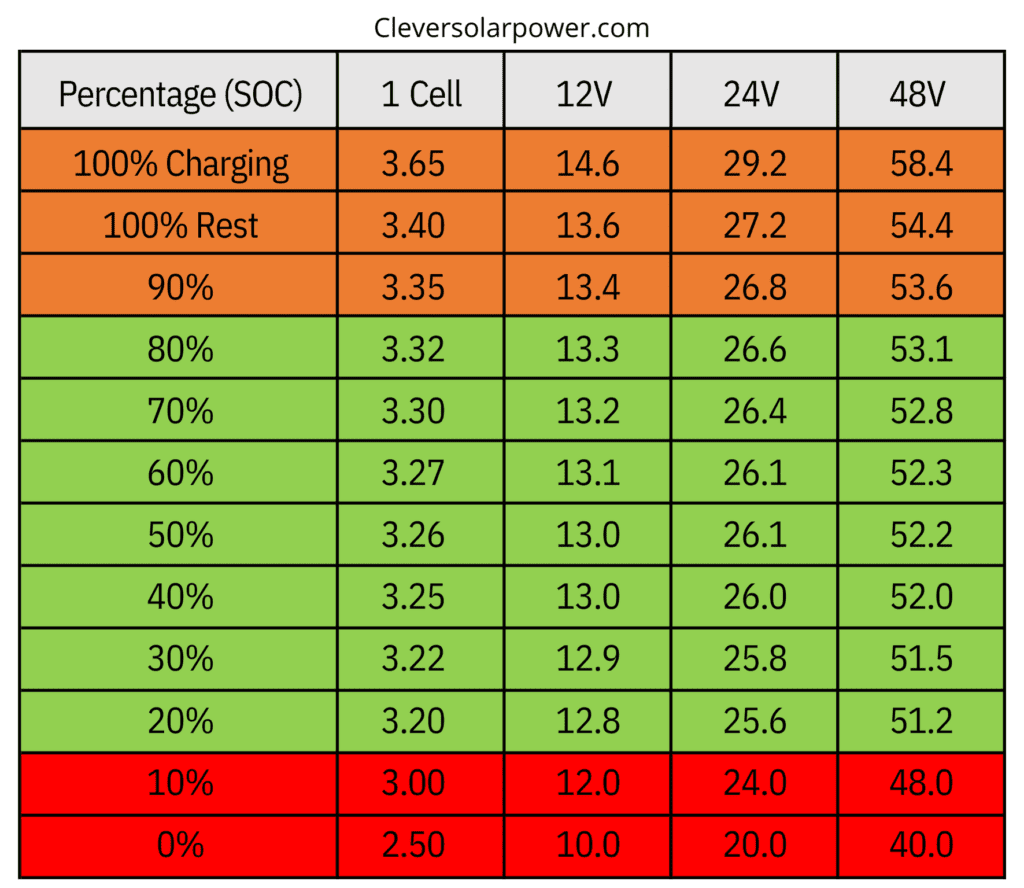The best settings for a battery management system (BMS) for a lithium iron phosphate (LiFePO4) battery will depend on the specific characteristics of the battery and the application in which it is being used. Here are some general guidelines for configuring a BMS for a LiFePO4 battery:
Voltages
Charge voltage: The charge voltage for a LiFePO4 battery should typically be set to around 3.6 volts per cell. This will ensure that the battery is charged to its full capacity while minimizing the risk of overcharging, which can damage the battery.
Discharge voltage: The discharge voltage for a LiFePO4 battery should be set to around 2.5-3.0 volts per cell to ensure that the battery is not discharged too deeply, which can reduce its overall life and performance.
Cell voltage high disconnect: 3.6V for 100% or 3.35V for 90%
Cell voltage low disconnect: 2.5V for 0% or 3V for 10%
Sum high voltage disconnect: multiply high cell disconnect voltage by the number of cells you have.
Sum low voltage disconnect: multiply low cell disconnect voltage by the number of cells you have.
Different voltage protect: 0.5V
Balance open start voltage: 2.5V
Balance diff voltage: 0.05V

Current
Charge current: The charge current for a LiFePO4 battery should be set based on the battery’s capacity and the available charging source. For example, a 100 Ah battery with a 10 A charger would have a charge time of 10 hours. It’s generally best to use the lowest possible charge current that allows the battery to be fully charged within a reasonable time.
Discharge current: The discharge current for a LiFePO4 battery should be set based on the maximum load the battery is expected to support. For example, if the maximum load on the battery is expected to be 100 A, the discharge current should be set to at least 100 A.
Charge overcurrent protect: Your battery capacity * charge C-rate = 100Ah*0.5C=50A
Discharge overcurrent protect: Your battery capacity * discharge C-rate = 100Ah*0.5C=50A
Keep in mind the maximum current of the BMS. I would have more than 80% of the rated current. So for a 200Ah battery with a 0.5C rate and 100A BMS, the maximum current would be 80Amps.
For more information about C-rate, watch my video here:
Temperature settings
Temperature limits: The BMS should be configured to prevent the battery from being charged or discharged outside of a safe temperature range. For a LiFePO4 battery, this range is typically 32-113°F or 0-45°C. Do not let the battery freeze. This will destroy the battery when charged. It can still deliver a small current when frozen.
Conclusion
It’s important to note that these are general guidelines, and the specific settings for your BMS will depend on the characteristics of your particular battery and the specific application in which it is being used. For example, 4cells, 8 cells, or 16 cells.
It’s always best to read the manufacturer’s datasheet and instructions and follow good battery management practices to ensure the safe and optimal operation of your LiFePO4 battery.
Read my article on the best BMS for LiFePO4 here.
 I have written a book that contains all the information you need to get started with off-grid solar power.
I have written a book that contains all the information you need to get started with off-grid solar power.
With over 1,800 reviews at 4.5 stars, I can almost guarantee that this book will save you $100s on buying the right equipment.
You can get it here on Amazon.com

I’m an off-grid enthusiast. I created this website to give clear and straight-to-the-point advice about solar power. I’m also the author of the book ‘Off-grid solar power simplified‘. Read more about me on my about page, check out my Youtube channel, or send me a message.
Very good work. What needs to be done to protect Lifepo4 battery in winter. Is it ok let them be exposed to cold below freezing as long as you do not charge them?
It is generally not recommended to store a lithium iron phosphate (LiFePO4) battery in freezing temperatures. LiFePO4 batteries can be damaged by low temperatures, which can affect their performance and lifespan.
At very low temperatures, the battery’s internal resistance can increase, which can cause the battery to discharge more quickly and reduce its capacity. Additionally, the chemical reactions inside the battery can slow down or stop completely at very low temperatures, which can also affect the battery’s performance.
If you need to store a LiFePO4 battery in a cold environment, it is important to keep the battery warm (above freezing). It is also a good idea to fully charge the battery before storing it, as a fully charged battery is less likely to be damaged by low temperatures. You can use a seed germination heat mat powered by the battery to keep it from freezing.
LiFePO4 batteries are more resistant to cold temperatures than other types of lithium-ion batteries, but it is still best to avoid storing them in freezing conditions if possible.
Can i use 12v 30A BMS For 50ah lifepo4 battery and 500w inverters for my solar generator.
A 12V 30A BMS can only deliver 360W.So if you use more than that, the BMS will shut down.
Okay thanks. Can i use 300w inverter if 350 is not available ?
Do i also need to use charge controller after using BMS for solar generator ?
Hi Nick,
Just read your article, very informative. I have a battery bank consisting of 6 100Ah 48v batteries supplied by Coremax Technology Company Ltd. (China) – terrible support (none when there is a problem) !
They are working, however, not all batteries have the same BMS set up eg. on most, the battery protection is not enabled.
I get no reply from Coremax since we reported a problem with one of the batteries (despite the so called 10 year warranty)
My question is – is there a generic software available that I can use to adjust the BMS settings ? their manual refers to software but no detail.
Any help would be very much appreciated.
Peter
I see it’s not a standard server rack battery. I don’t know of any generic software that can program a BMS. However, you can fit your own BMS into the battery. You will have to replace the original one, which would void warranty (if there ever was one to start with).
Hi Nick,
Thanks for responding, not sure if I want to jump in and replace the bms’s just yet, as the battery bank seems to be working OK at the moment, however, as I add capacity I will certainly not be using Coremax again and will probably build my own, unless I can find a suitable battery in the UK with good support.
Many thanks again.
Thanks for sharing your experience with Coremax Peter. If the BMS is not damaged, then you should not replace it.